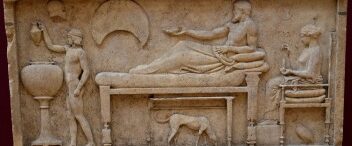Is art history an inherently Western discipline? What problems arise when art historians study non-Western objects? In what ways do we see colonialism manifest in the study of Gandharan art during the late 19th century? Stanley K. Abe expertly addresses these lofty questions (and more) in his in-depth essay titled “Inside the Wonder House: Buddhist Art and the West.” In the essay, Abe argues that scholarly debates over stylistic influence were not only disputes over the interpretation of evidence but contestations over how the East would be represented by the West.”
Abe begins with an analysis of Rudyard Kipling’s 1901 novel Kim to illustrate how so-called “Greco-Buddhist art” was viewed from the position of an Anglo-Indian. The included passages reveal three important aspects about the Lahore Museum:
- It was built by colonial powers without regard for native experience or expertise.
- The contents are gate-kept by a colonial administration which oversees the collection and preservation practices of the museum.
- The sculptures in question were made in the distant past and therefore “superior” (scare quotes intended) to what natives are capable of producing in modern times.
It is important to recognize that British superiority is shown here by the ability to recollect the artworks and reorganize them in a Western scientific way in the museum. The drive toward categorization and classification through museums is rooted in the tradition of Western academia, which presents several problems when removed from that context. The “Wonder House” is used as a tool for demonstrating the superiority of Western forms of knowledge while discounting native forms of knowledge. The curator, with the help of European books and the training of an art historian, was able to present Buddhist art in an authoritative manner to a western audience. However, this was made only possible by the strategic control and exclusion of the native presence from the discourse of art history. Scholars (Leitner, Foucher, Smith, etc.) used these methods in creating the discourse of Greco-Buddhist Art.


Here, I’ve provided an example of the shoddy comparisons which were repeatedly made between Gandharan and Greco-Roman sculpture. The image on the left features a scene of the Buddha’s death, or Mahaparinirvana, while the image on the right is from a Greek funerary stele showing a banquet scene. Even if these images were not depicting polar opposite scenes, I struggle to see more than a few insubstantial stylistic similarities.
Vincent Smith claimed that since the influence came from ancient Rome (which was itself influenced by ancient Greece), these sculptures were “inferior copies” of Greek works. He adds that there are “only echoes of the second rate Roman art of the third and fourth countries” and it is “never Greek enough in its inability to match the achievements of the classical West” G.W. Leitner, on the other hand, made an effort to incorporate this Buddhist art as a natural part of a universal history in which East-West exchange was thought to be symmetrical and naturally beneficial. However, he and Smith both falter by trying to incorporate India into the molds and schemes of Western knowledge.